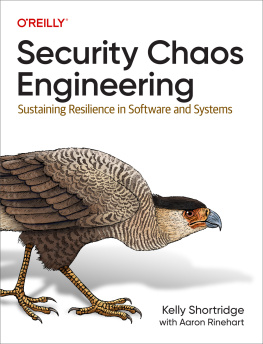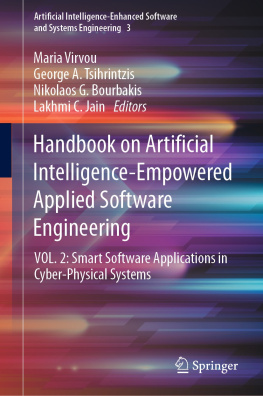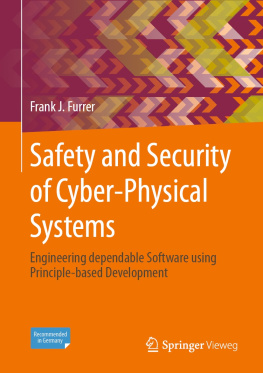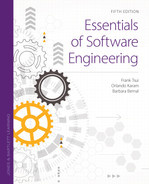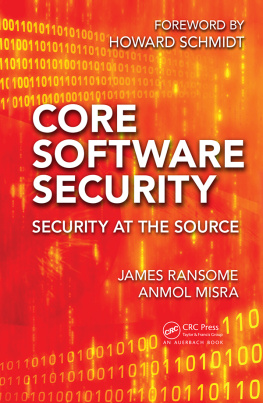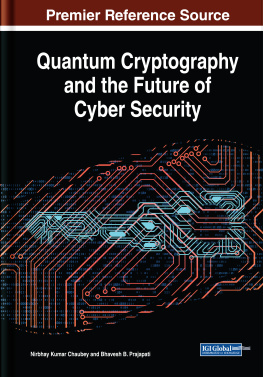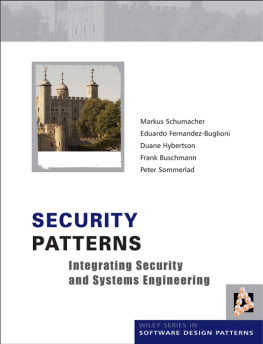About This E-Book
EPUB is an open, industry-standard format for e-books. However, support for EPUB and its many features varies across reading devices and applications. Use your device or app settings to customize the presentation to your liking. Settings that you can customize often include font, font size, single or double column, landscape or portrait mode, and figures that you can click or tap to enlarge. For additional information about the settings and features on your reading device or app, visit the device manufacturers Web site.
Many titles include programming code or configuration examples. To optimize the presentation of these elements, view the e-book in single-column, landscape mode and adjust the font size to the smallest setting. In addition to presenting code and configurations in the reflowable text format, we have included images of the code that mimic the presentation found in the print book; therefore, where the reflowable format may compromise the presentation of the code listing, you will see a Click here to view code image link. Click the link to view the print-fidelity code image. To return to the previous page viewed, click the Back button on your device or app.
Cyber Security Engineering
A Practical Approach for Systems and Software Assurance
Nancy R. Mead
Carol C. Woody

Boston Columbus Indianapolis New York San Francisco
Amsterdam Cape Town Dubai London Madrid Milan Munich
Paris Montreal Toronto Delhi Mexico City So Paulo Sydney
Hong Kong Seoul Singapore Taipei Tokyo
The SEI Series in Software Engineering
Many of the designations used by manufacturers and sellers to distinguish their products are claimed as trademarks. Where those designations appear in this book, and the publisher was aware of a trademark claim, the designations have been printed with initial capital letters or in all capitals.
CMM, CMMI, Capability Maturity Model, Capability Maturity Modeling, Carnegie Mellon, CERT, and CERT Coordination Center are registered in the U.S. Patent and Trademark Office by Carnegie Mellon University.
ATAM; Architecture Tradeoff Analysis Method; CMM Integration; COTS Usage-Risk Evaluation; CURE; EPIC; Evolutionary Process for Integrating COTS Based Systems; Framework for Software Product Line Practice; IDEAL; Interim Profile; OAR; OCTAVE; Operationally Critical Threat, Asset, and Vulnerability Evaluation; Options Analysis for Reengineering; Personal Software Process; PLTP; Product Line Technical Probe; PSP; SCAMPI; SCAMPI Lead Appraiser; SCAMPI Lead Assessor; SCE; SEI; SEPG; Team Software Process; and TSP are service marks of Carnegie Mellon University.
Special permission to reproduce portions of Mission Risk Diagnostic (MRD) Method Description, Common Elements of Risk, Software Assurance Curriculum Project, Vol 1, Software Assurance Competency Model, and Predicting Software Assurance Using Quality and Reliability Measures 2012, 2006, 2010, 2013, and 2014 by Carnegie Mellon University, in this book is granted by the Software Engineering Institute.
The authors and publisher have taken care in the preparation of this book, but make no expressed or implied warranty of any kind and assume no responsibility for errors or omissions. No liability is assumed for incidental or consequential damages in connection with or arising out of the use of the information or programs contained herein.
For information about buying this title in bulk quantities, or for special sales opportunities (which may include electronic versions; custom cover designs; and content particular to your business, training goals, marketing focus, or branding interests), please contact our corporate sales department at or (800) 382-3419.
For government sales inquiries, please contact .
For questions about sales outside the U.S., please contact .
Visit us on the Web: informit.com/aw
Library of Congress Control Number: 2016952029
Copyright 2017 Pearson Education, Inc.
All rights reserved. Printed in the United States of America. This publication is protected by copyright, and permission must be obtained from the publisher prior to any prohibited reproduction, storage in a retrieval system, or transmission in any form or by any means, electronic, mechanical, photocopying, recording, or likewise. For information regarding permissions, request forms and the appropriate contacts within the Pearson Education Global Rights & Permissions Department, please visit www.pearsoned.com/permissions/.
ISBN-13: 978-0-134-18980-2
ISBN-10: 0-134-18980-9
Text printed in the United States on recycled paper at RR Donnelley in Crawfordsville, Indiana.
First printing: November 2016
Praise for Cyber Security Engineering
This book presents a wealth of extremely useful material and makes it available from a single source.
Nadya Bartol, Vice President of Industry Affairs and
Cybersecurity Strategist, Utilities Technology Council
Drawing from more than 20 years of applied research and use, CSE serves as both a comprehensive reference and a practical guide for developing assured, secure systems and softwareaddressing the full lifecycle; manager and practitioner perspectives; and people, process, and technology dimensions.
Julia Allen, Principal Researcher,
Software Engineering Institute
For my husband Woodyhe was my mentor, sounding board, and best friend
Nancy
With thanks to my husband Robert for his constant love and support and in memory of my parents who taught me the value of hard work and the constant pursuit of knowledge
Carol
Contents at a Glance
Register your copy of Cyber Security Engineering at informit.com for convenient access to downloads, updates, and corrections as they become available. To start the registration process, go to informit.com/register and log in or create an account. Enter the product ISBN 9780134189802 and click Submit. Once the process is complete, you will find any available bonus content under Registered Products.
Contents
Acknowledgments
We are pleased to acknowledge the encouragement and support of many people who were involved in the book development process. Rich Pethia and Bill Wilson, the leaders of the CERT Division at the Software Engineering Institute (SEI), encouraged us to write the book and provided support to make it possible. Our SEI technical editors edited and formatted the entire manuscript and provided many valuable suggestions for improvement, as well as helping with packaging questions. Sandy Shrum and Barbara White helped with the early drafts. Hollen Barmer worked across the Christmas holidays to edit the draft. Matthew Penna was tremendously helpful in editing and formatting the final draft for submission. Pennie Walters, one of our editors, and Sheila Rosenthal, our head librarian, helped with obtaining needed permissions to use previously published materials.
Much of the work is based on material published with other authors. We greatly appreciated the opportunity to collaborate with these authors, and their names are listed in the individual chapters that they contributed to, directly or indirectly. In addition, we would like to acknowledge the contributions of Mark Ardis and Andrew Kornecki to .


